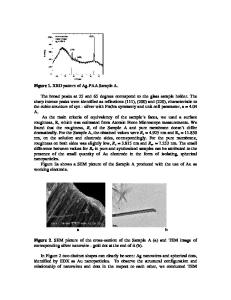Synthesis, characterization, and antimicrobial properties of strontium-substituted hydroxyapatite
- PDF / 3,305,567 Bytes
- 10 Pages / 595.276 x 790.866 pts Page_size
- 48 Downloads / 342 Views
RESEARCH
Synthesis, characterization, and antimicrobial properties of strontium-substituted hydroxyapatite B. Krishna Sarath Kumar 1 & M. Jagannatham 2 & B. Venkateswarlu 1 & Ravikumar Dumpala 3 & B. Ratna Sunil 4 Received: 10 April 2020 / Revised: 23 August 2020 / Accepted: 7 October 2020 # Australian Ceramic Society 2020
Abstract Ion-substituted hydroxyapatite (HAP) offers several advantages compared with pure HAP. Since the calcium amount is relatively lower compared with the stoichiometric ratio of pure HAP, the resulting calcium deficiency in ion-substituted HAP leads to higher degradation in the physiological environment. Therefore, ion-substituted HAP has promising applications in the biomedical industry, particularly in drug delivery systems. In the present work, strontium-substituted HAP (Sr-HAP) was prepared by wet chemical precipitation method. The powders were characterized by X-ray diffraction (XRD) method and scanning electron microscopy (SEM). The crystallite size of Sr-HAP was calculated as ≈ 9 nm. Furthermore, structural characterization of Sr-HAP was done by Rietveld refinement and the substituting atomic sites and occupancies were obtained. The atomic positions occupied by the substituted Sr atoms in the calcium (Ca) atomic positions in the hcp unit cell were identified. The unit cell parameters of synthesized Sr-HAP were precisely calculated. The synthesized Sr-HAP powders were compacted and the antimicrobial properties were assessed by using Escherichia coli (E. coli) and Sporosarcina pasteurii (S. pasteurii). From the antimicrobial studies, it was understood that Sr-HAP has shown lower viability of these strains compared with pure HAP which is an indication of antimicrobial properties of Sr-HAP. Keywords Strontium . Hydroxyapatite . Rietveld refinement . Crystal structure . Antimicrobial
Introduction Hydroxyapatite (HAP) is a ceramic material composed of calcium (Ca) and phosphorous (P) usually observed in natural bone in the crystalline form [1]. Synthesized HAP is widely used in several biomedical applications including orthopedic applications, maxillofacial surgeries, and bone filling applications [2, 3]. HAP can be derived from natural resources such as fish bones and scales, sea corals, and eggshells [4–10] or
* B. Ratna Sunil [email protected]; [email protected] 1
Department of Metallurgical and Materials Engineering, Rajiv Gandhi University of Knowledge Technologies (AP-IIIT), Nuzvid 521202, India
2
Department of Metallurgical and Materials Engineering, Indian Institute of Technology Madras, Chennai 600036, India
3
Department of Mechanical Engineering, Visvesvaraya National Institute of Technology, Nagpur 440010, India
4
Department of Mechanical Engineering, Bapatla Engineering College, Bapatla 522101, India
can be synthetically produced in laboratories through different routes such as wet chemical precipitation, ultrasonication, microwave irradiation, sol-gel, hydrothermal, spray pyrolysis, and electrodeposition [11–15]. Several ions (magnesium, zinc, cadmium
Data Loading...










